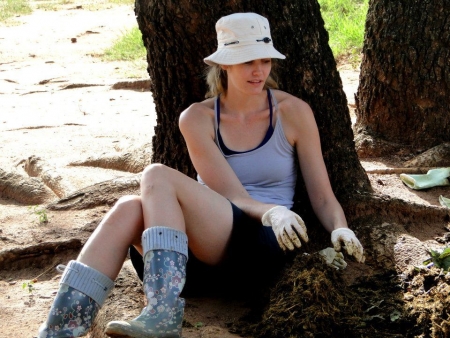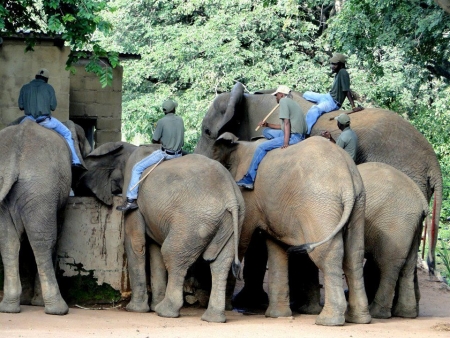African elephants may transport seeds farther than any other land animal


A bull elephant eats from a fig tree in Kenya. Savanna elephants can transport seeds many kilometers and likely help maintain the genetic diversity of trees
The African savanna elephant, the largest living terrestrial animal, now appears to be the longest distance transporter of seeds. New research into elephant dung in South Africa, by UCT MSc student Katherine Bunney and Professor William Bond, from the Department of Biological Sciences indicates that elephants can transport seeds up to 65 kilometers, which is 30 times farther than savanna birds take seeds. This finding indicates that elephants play a significant role in maintaining the genetic diversity of trees on the savanna.
“The scale of movement is really mind opening,” says Greg Adler, an ecologist at the University of Wisconsin in Oshkosh who was not involved in the study. “The implication is that elephants are absolutely critical to the integrity of these African savanna ecosystems.”
Plants make fruit to encourage animals to eat and then move their seeds to new locations. Not only does this help expand the plant population, it also prevents seedlings from competing with their parents or suffering from any pathogens that may have accumulated in their home turf. Seeds lucky enough to be eaten by a large animal drop onto their new habitat encased in a big lump of nutrients. For some species, passing through the digestive tract of an animal increases the percentage of seeds that sprout. There seem to be other benefits as well; elephant dung for example, somehow protects seeds from predation by beetles.

Kath Bunney sorts through elephant dung
Katherine Bunney became interested in the role of elephants in moving seeds while a graduate student in ecology at the University of Cape Town in South Africa. She had read about large fruit in Central and South American forests that falls to the ground and rots because it evolved to be eaten by large herbivores now extinct. “I thought, ‘How lucky we are to still have ours,’” she says. “I wanted to start exploring what they do.” Studies in Asia and Africa have shown that forest elephants consume a large amount and diversity of fruit and spread the seeds, but little research had been done on seed dispersal by savanna elephants.
The first thing that Bunney needed to know was how long seeds stay inside elephants while winding through their 20-meter-long intestines. For a week, she fed fruit to four elephants in a sanctuary near Kruger National Park in South Africa. She gave them honeydew melons because their smaller, softer seeds are relatively easy to distinguish from the seeds of the tree fruit the elephants were already eating.
Keepers followed each elephant during the day, bagging the dung and bringing it back to Bunney, who sorted through hundreds of kilograms and counted the melon seeds. (It took a sharp eye, because the seeds were stained the same olive green as the rough, dry dung.) At night, Bunney fetched the dung herself from each elephant’s compound. “It was quite all-consuming and nonstop,” she says. The elephants, she found, defecated most of the seeds within 33 hours, while the last ones plopped out after 96 hours.
Seedy competition
Among seed dispersers on the savanna (black), elephants are the champs in how far they can move seeds, as measured and inferred by researchers. Globally, migratory birds top the list.
The next step was to find out how far savanna elephants typically move. Bunney reached out to a conservation group called Elephants Alive that as part of its research has put collars with tracking devices on elephants in Greater Kruger National Park. With 8 years of data on 38 elephants, Bunney calculated the probability of seeds being moved various distances. For any given fruit, an elephant would move half the seeds 2.5 kilometers from where they were eaten, and 1% of seeds would move farther than 20 kilometers, Bunney and her colleagues report online in Biotropica. In extreme cases a seed could travel up to 65 kilometers, such as when male elephants take long treks searching for a mate.
“This is amazing!” says Mauro Galetti, an ecologist at São Paulo State University in São Paulo, Brazil, who has studied seed dispersal by vertebrates for more than 20 years. Bunney suspects seeds travel even farther in Namibia, where elephants must roam to find water. In comparison, the likely maximum distance for seed transport by forest elephants has been calculated at just 5 to 6 kilometers. These animals probably have to walk less far than savanna elephants to find fruit, Bunney says.
The world record for seed dispersal probably belongs to a bird (see chart). Most birds aren’t thought to be long-haul movers, because they tend to pass seeds through their guts quickly to shed the weight. However, some light, sticky seeds attach to feathers or legs and hitchhike long distances, and a study last year revealed seeds in the digestive tracts of migratory birds that had flown at least 300 kilometers.
On the savanna, elephants certainly trump the other known seed dispersers. Ants tend to move seeds about a meter, vervet monkeys less than 850 meters, and trumpeter hornbills as far as 2000 meters. In addition to their more expansive range, elephants can eat larger fruit than many other species, such as the meter-long seed pods of the sausage tree. And then there’s the sheer volume: Each elephant may deposit nearly 3200 seeds a day, estimates Joseph Dudley, an ecologist with Leidos, a science and engineering company in Germantown, Maryland, who studied savanna elephants in Zimbabwe in the 1990s.
The genetic diversity of many tree species is maintained, and local inbreeding prevented, when their seeds are scattered widely by elephants. “They’re seeding genes—literally—across the landscape.” And it could provide insurance against climate change, he adds, by taking seeds into areas where the conditions may become suitable for the trees in the future.

Elephants in the sanctuary in South Africa
Elephants are doing well in South Africa, despite an increase in illegal killings, but many populations elsewhere are declining because of poaching for ivory. If these creatures are lost, and their seeds no longer dispersed, Adler says, tree species in the savanna might have smaller ranges and perhaps eventually vanish. Bunney, now a Ph.D. student at the University of Pretoria in South Africa, is exploring the degree to which various savanna trees depend on elephants for seed dispersal, including the iconic baobab and marula. “The extinction of elephants would have a profound effect on plant survival and gene flow,” Galetti warns.
